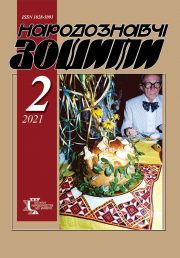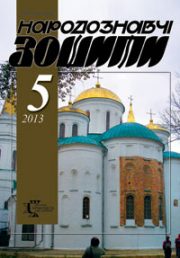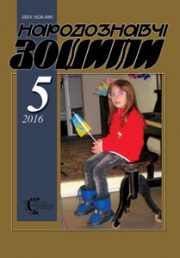The Ethnology Notebooks. 2020. № 3 (153), 637—646
UDK 7.77.0/7.03
DOI https://doi.org/10.15407/nz2020.03.637
OLD CONNECTIONS THROUGH EAST BESKYDY PASSES (CERTAIN ASPECTS ACCORDING TO TOPOGRAPHIC DATA ANALYSIS)
HOSHCHITSKYY Artem
ORCID ID: https://orcid.org/0000-0001-8680-2124
researcher of ancient Carpathian culture,
Contacts: e-mail: artem.hoshchitskyy@ukr.net
Abstract. Introduction: According to archeological sources, in the past the Carpathian Mountains were inhabited by hunters and gatherers, and later by herders and farmers. In terms of ethnogenesis this territory has some characteristics regarding its geographic location, terrain and natural specifics. Problem statement: Within the aforementioned territory the system of routes, on which the popular well-being, security and cultural exchange depended, had always operated. From both sides of the Carpathia’s researchable part’s watershed there are saddlebacks — the lowered areas on the crests, the ones that could have been the ancient passes with regards to optimal characteristics of their relief. The purpose of the publication: According to the analysis of topographic map of such hypothetical passes, considering the area between the Uzhok and Torun (Vyshkiv) passes, there could have been at least 20 items, which, by the way, are equally good regarding natural and geographic circumstances. In the Ukrainian Carpathian highlands the archeological items are scarce, there are a slightly bigger number of them near the Verkhovyna Basin Crest (mostly casual archeological finds and treasures). The treasures indicate the ancient tracks’ origins as well as, in our opinion, the agelong placenames (the ones that are related to routes and passes). The article used the main methods of historical research — interdisciplinary, complex, analytical and field research methods. Conclusions: We believe that the information we can gather by researching the area’s topography, with fieldwork observation and topographic map, can be considerable source base to use reconstructing ancient history. Discovering the ancient sites in places of the hypothetical roads and passes, might be perceived as the fieldwork’s results.
Keywords: Ukrainian Carpathians; Boykivshchyna; ways of connecting the Ukrainian Carpathians; passes of the Eastern Beskids; archeology of mountains.
Received 17.03.2020
REFERENCES
Ustyianovych, K. (1993). The road to Beskid: «Svyatoslavia» and the tradition of Svyatoslav 1015. In Travel to the Ukrainian Carpathians (Pp. 199—219). Lviv: Kameniar [in Ukrainian].
Kobil’nyk, V. (1933). «Rus’ka put’». In Litopys Bojkivschyny: zapysky prysviacheni doslidam istorii, kul’tury I pobutu bojkivs’koho plemeni (Vol. IІ, part ІІІ, pp. 39—48) [in Ukrainian].
Kalynovych, N., & Sytnyk, O. (2003). The history of popular of the Ukrainian Carpathians. In ZNTSH (Vol. ХІІ, pp. 44—53) [in Ukrainian].
Томенчук, Б. (2011). Ancient Transcarpathian Ways in the Hutsul Region. In Hutsulian Ancientries: The Sources from the Ethnic History of the Ukrainian Carpathian populace. Catalogue of Historical and Cultural Items: in 2 volumes (Vol. II, pp. 250—255). Ivano-Frankivs’k [in Ukrainian].
Hoshko, Yu.H. (1976). Population of the Ukrainian Carpathians of the XV—XVIII centuries. Settlement. Migration. Everyday life. Кyiv: Naukova dymka [in Ukrainian].
Hoshko, Yu.H. (1991). Craft and trade in the Ukrainian Carpathians of the 15th—19th centuries. Кyiv: Naukova dymka [in Ukrainian].
Ethnogenesis and ethnic history of the Ukrainian Carpathians. (1999). (Vol. 1, pp. 1—608). Lviv: In-tut narodoznavstva NANU [in Ukrainian].
Hlushko, M.S. (1993). The Lines of Communication and the Means of Transport in the Ukrainian Carpathians in the 2nd half of the ХІХ — the beginning of the ХХth c. Кyiv: Naukova dymka [in Ukrainian].
Tuholukov, V. (1980). Those Who Walk Across the Ranges. Krasnoiarsk [in Russian].
Zubryts’kyj, M. (1905). Feeding, buying and selling sheep in Mshantsy of the Old Sambir County In Materiialy do ukrains’ko-rus’koi etnolohii (Vol. VI, pp. 26—34) [in Ukrainian].
Callanan, M. (2012). Central Norwegian Snow Patch Archaeology: Patterns past and present. In Arctic (65(5), рр. 178—188) [in English].
Bagolini, B., Dalri, L., Lippert, A. and Nothdurfter, H. (1995). Der Mann im Eis: Die Fundbergung 1992 am Tisenjoch, Gem. Schnals, Sьdtirol. In: Der Mann im Eis. Neue Funde und Ergebnisse (pp. 3—22). Vienna; New York: Springer [in Norway].
Kobil’nyk, V. (1934). From the archeology of Boykivschyna. III list of artefacts. In Litopys Bojkivschyny: zapysky prysviacheni doslidam istorii, kul’tury i pobutu bojkivs’koho plemeni (Vol. IІІ, part IV, pp. 20—22) [in Ukrainian].
Zhaki A. (1962). Mountain archeology and problems of Carpathian archeology. In Acta archaeologica Carpatica (Vol. IV, part I—ІІ, pp. 4—75) [in Polish].
Zhydyk, Yu. (2002). New artifacts of ancient Carpathian history from the village of Lavochne, Skole district. In Archaeological research at Lviv University (Vol. V, pp. 390—396) [in Ukrainian].
Chernysh, O.P. (1992). To the Issue of Time and Routes of the East Carpathians’ Oldest Colonization by the Stone-Age People. In New materials on the archeology of Carpathian and Volhyni (Vol. II, pp. 12—13) [in Ukrainian].
Kochkin, I. (2011). Ethno-archaeological survey of the salt sources of Halych Hutsul region. In Tustan Memorial Sites in Context of the Colonization of the Ukrainian Carpathians in the Pre-Historic Age and the Middle Ages. International scientific conference. Theses (Pp. 41—42). L’viv; Tustan’ [in Ukrainian].
Petryk, V., & Petryk, A. (2011). Salt industry in the Pre-Carpathian region. In Tustan Memorial Sites in Context of the Colonization of the Ukrainian Carpathians in the Pre-Historic Age and the Middle Ages. International scientific conference. Theses. (Pp. 43—44). L’viv; Tustan’ [in Ukrainian].
Kobil’nyk, V. (1931). From the archeology of Boykivschyna. In Litopys Bojkivschyny: zapysky prysviacheni doslidam istorii, kul’tury I pobutu bojkivs’koho plemeni (Vol. I, part I, pp. 39—40) [in Ukrainian].
Vynokur, I.S., Hutsal, A.F., Peniak, S.I., Tymoschuk, B.O., & Yakubovs’kyj, V.I. (Eds.). (1984). Кyiv: Naukova dymka [in Ukrainian].
Balahuri, E.A., & Peniak, S.I. (1976). Transcarpathia — Slavic land. Uzhhorod [in Ukrainian].
Kobal’, J. (2007). New finds of ancient bronze objects in Transcarpathia. In Materials and studies on archeology of Sub-Carpathian and Volhynian area (Vol. 11) [in Ukrainian].
Onyshkevych, M.J. (1984). Glossary of Boyko’s dialects (Vol. 1, А—Н). Кyiv: Naukova dymka [in Ukrainian].
Khudash, M.L., & Demchuk, M.O. (1991). The Origins of the Ukrainian Carpathian and Precarpathian localities names. Кyiv: Naukova dymka [in Ukrainian].
Khudash, M. (2006). Ukrainian Carpathian and Precarpathian localities names. Lviv: In-tut narodoznavstva NANU [in Ukrainian].






